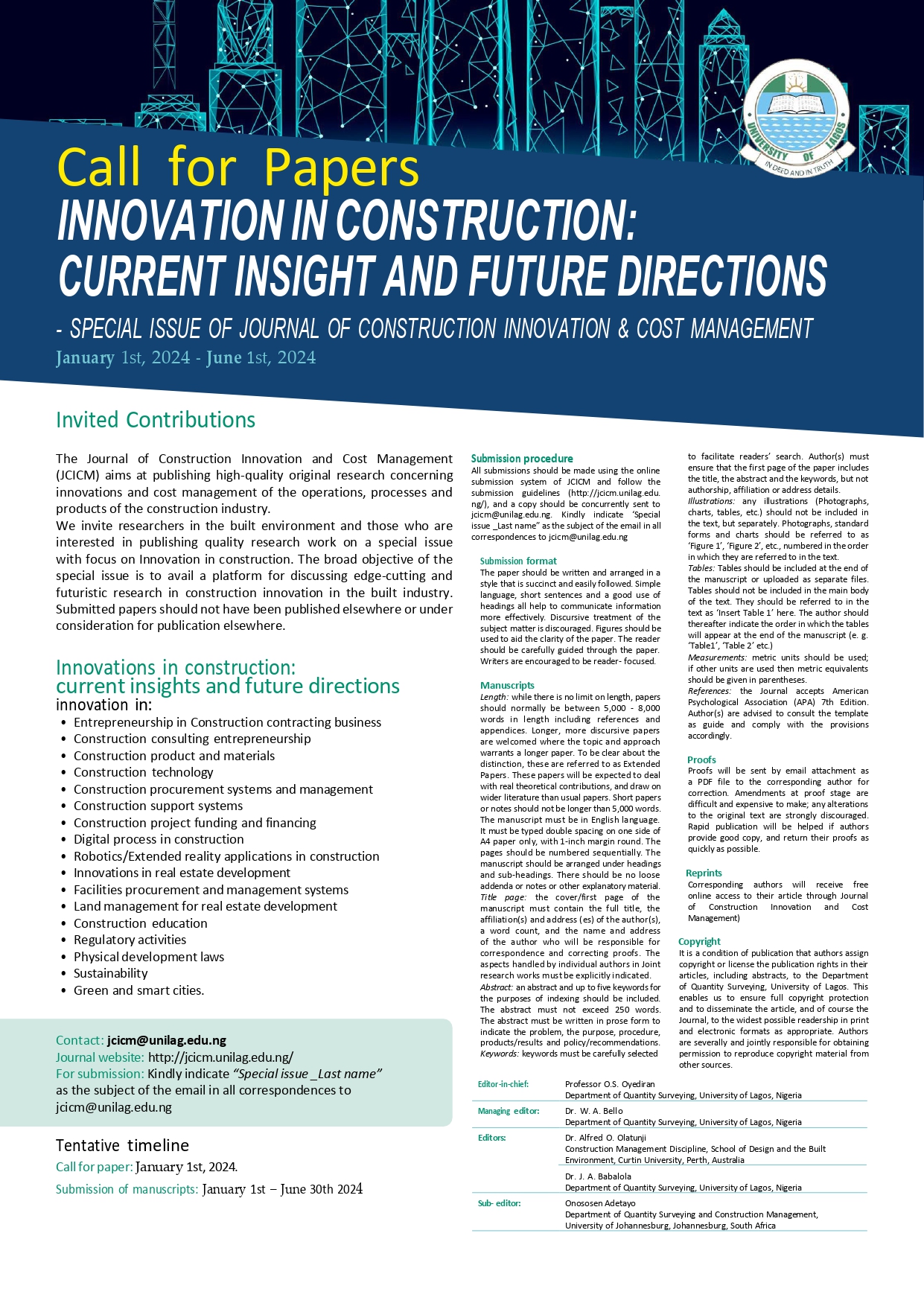
Call for Papers
INNOVATION IN CONSTRUCTION:
CURRENT INSIGHT AND FUTURE DIRECTIONS
- SPECIAL ISSUE OF JOURNAL OF CONSTRUCTION INNOVATION & COST MANAGEMENT
January 1st, 2024 - June 1st, 2024
Invited Contributions
The Journal of Construction Innovation and Cost Management (JCICM) aims at publishing high-quality original research concerning innovations and cost management of the operations, processes and products of the construction industry.
We invite researchers in the built environment and those who are interested in publishing quality research work on a special issue with focus on Innovation in construction. The broad objective of the special issue is to avail a platform for discussing edge-cutting and futuristic research in construction innovation in the built industry. Submitted papers should not have been published elsewhere or under consideration for publication elsewhere.
Innovations in construction:
current insights and future directions
innovation in:- Entrepreneurship in Construction contracting business
- Construction consulting entrepreneurship
- Construction product and materials
- Construction technology
- Construction procurement systems and management
- Construction support systems
- Construction project funding and financing
- Digital process in construction
- Robotics/Extended reality applications in construction
- Innovations in real estate development
- Facilities procurement and management systems
- Land management for real estate development
- Construction education
- Regulatory activities
- Physical development laws
- Sustainability
- Green and smart
Submission procedure
All submissions should be made using the online submission system of JCICM and follow the submission guidelines (http://jcicm.unilag.edu. ng/), and a copy should be concurrently sent to jcicm@unilag.edu.ng. Kindly indicate ‘Special issue _Last name” as the subject of the email in all correspondences to jcicm@unilag.edu.ng
Submission formatThe paper should be written and arranged in a style that is succinct and easily followed. Simple language, short sentences and a good use of headings all help to communicate information more effectively. Discursive treatment of the subject matter is discouraged. Figures should be used to aid the clarity of the paper. The reader should be carefully guided through the paper. Writers are encouraged to be reader- focused.
Manuscripts
Length: while there is no limit on length, papers should normally be between 5,000 - 8,000 words in length including references and appendices. Longer, more discursive papers are welcomed where the topic and approach warrants a longer paper. To be clear about the distinction, these are referred to as Extended Papers. These papers will be expected to deal with real theoretical contributions, and draw on wider literature than usual papers. Short papers or notes should not be longer than 5,000 words. The manuscript must be in English language. It must be typed double spacing on one side of A4 paper only, with 1-inch margin round. The pages should be numbered sequentially. The manuscript should be arranged under headings and sub-headings. There should be no loose addenda or notes or other explanatory material. Title page: the cover/first page of the manuscript must contain the full title, the affiliation(s) and address (es) of the author(s), a word count, and the name and address of the author who will be responsible for correspondence and correcting proofs. The aspects handled by individual authors in Joint research works must be explicitly indicated.
Abstract: an abstract and up to five keywords for the purposes of indexing should be included. The abstract must not exceed 250 words. The abstract must be written in prose form to indicate the problem, the purpose, procedure, products/results and policy/recommendations. Keywords: keywords must be carefully selected.
to facilitate readers’ search. Author(s) must ensure that the first page of the paper includes the title, the abstract and the keywords, but not authorship, affiliation or address details.
Illustrations: any illustrations (Photographs, charts, tables, etc.) should not be included in the text, but separately. Photographs, standard forms and charts should be referred to as ‘Figure 1’, ‘Figure 2’, etc., numbered in the order in which they are referred to in the text.
Tables: Tables should be included at the end of the manuscript or uploaded as separate files. Tables should not be included in the main body of the text. They should be referred to in the text as ‘Insert Table 1’ here. The author should thereafter indicate the order in which the tables will appear at the end of the manuscript (e. g. ‘Table1’, ‘Table 2’ etc.)
Measurements: metric units should be used; if other units are used then metric equivalents should be given in parentheses.
References: the Journal accepts American Psychological Association (APA) 7th Edition. Author(s) are advised to consult the template as guide and comply with the provisions accordingly.
Proofs
Proofs will be sent by email attachment as a PDF file to the corresponding author for correction. Amendments at proof stage are difficult and expensive to make; any alterations to the original text are strongly discouraged. Rapid publication will be helped if authors provide good copy, and return their proofs as quickly as possible.
Reprints
Corresponding authors will receive free online access to their article through Journal of Construction Innovation and Cost Management)
Copyright
It is a condition of publication that authors assign copyright or license the publication rights in their articles, including abstracts, to the Department of Quantity Surveying, University of Lagos. This enables us to ensure full copyright protection and to disseminate the article, and of course the Journal, to the widest possible readership in print and electronic formats as appropriate. Authors are severally and jointly responsible for obtaining permission to reproduce copyright material from other sources.
Contact: jcicm@unilag.edu.ng
Journal website: http://jcicm.unilag.edu.ng/
For submission: Kindly indicate “Special issue _Last name” as the subject of the email in all correspondences to jcicm@unilag.edu.ng
Tentative timeline
Call for paper: January 1st, 2024.
Submission of manuscripts: January 1st – June 30th 2024
